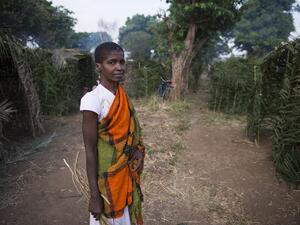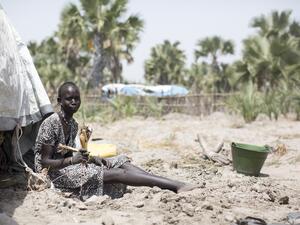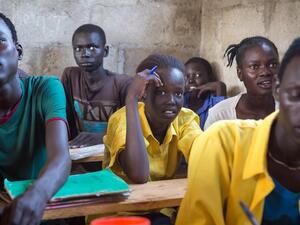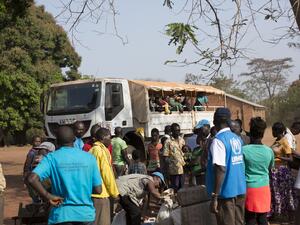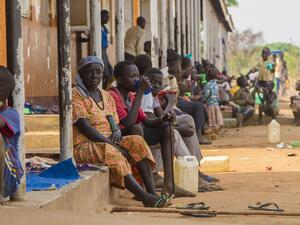New UNHCR airlifts for Sudanese refugees in Upper Nile
New UNHCR airlifts for Sudanese refugees in Upper Nile
Over the weekend UNHCR began a new emergency aid airlift for refugees in South Sudan's Upper Nile state. The flights are bringing supplies for 50,000 refugees who have fled conflict and related food shortages in Sudan's Blue Nile State.
Since Saturday, a UNHCR-chartered Ilyushin 18 aircraft has been doing two daily rotations to bring basic relief items from Juba to Paloich, an airstrip which UNHCR has recently negotiated access to. Paloich airport is 90km by road from the Jammam refugee settlement and 150km from Doro settlement, with Yusuf Batil settlement located between the two.
The aid includes kitchen sets, blankets, soap, plastic sheets, sleeping mats, jerry cans and mosquito nets. We are also bringing in equipment for drilling new boreholes to increase the supply of clean water, which is in severe shortage in the area.
With the new airlift, UNHCR is hoping to speed the delivery of these critical supplies. Difficult road conditions have been made worse by rains, causing considerable delays in our long-haul ground transport operations.
On 20 December last year, UNHCR launched an airlift from Nairobi to Juba, bringing within a month, enough supplies to cover the needs of the refugees who had fled to South Sudan from South Kordofan and Blue Nile. This was sufficient until the new surge of the past two months. As the influx grew UNHCR set up new supply routes through Ethiopia. We are also using barges on the River Nile.
With the security and humanitarian conditions deteriorating in South Kordofan and Blue Nile, a growing number of Sudanese have been seeking refuge in South Sudan, exceeding by far our original planning assumptions. In Upper Nile state for example, we had planned for 75,000 refugees but there are already some 105,000 people who have crossed from Blue Nile state.
Further west, in South Sudan's Unity state, the Yida refugee settlement currently has more than 55,000 refugees. This is 15,000 more people than a month ago and we are planning to ship additional supplies for them from Juba. The newcomers are settling on land which the authorities say is used for cattle grazing, causing concern to the local population. UNHCR is also worried about the proximity of this area to the border. UNHCR is working with the local communities and refugee leadership to foster good relations. We are also deploying a site planner to Yida to assist the new arrivals.
Meanwhile in Ethiopia, new arrivals from Sudan's Blue Nile State continue to be registered in Benishangul Gumuz Region, with some 36,527 refugees hosted in the area. We are currently relocating Sudanese refugees to the newly opened Bambasi camp, with the help of the International Organization for Migration. So far about 1,500 refugees have been relocated from the transit center at Ad-Damazin to Bambasi.
Our objective is to move all 14,000 refugees from Ad-Damazin at a rate of 2,000 people per week. Unlike Ad-Damazin, Bambasi is a safe distance from the border between Ethiopia and Sudan, and contains ample water sources. It is also a planned site where refugees not only receive food and non-food assistance, but also have community spaces. Bambasi can host up to 20,000 people.
Since June last year, nearly 200,000 Sudanese have been forced to flee to South Sudan and Ethiopia.
For more information on this topic, please contact:
- In Maban: Pumla Rulashe on mobile +211 922 407 462
- In Juba: In Juba: Terry Ongaro on mobile: +211 927 770 040
- In Geneva: Fatoumata Lejeune-Kaba on mobile +41 79 249 3483




